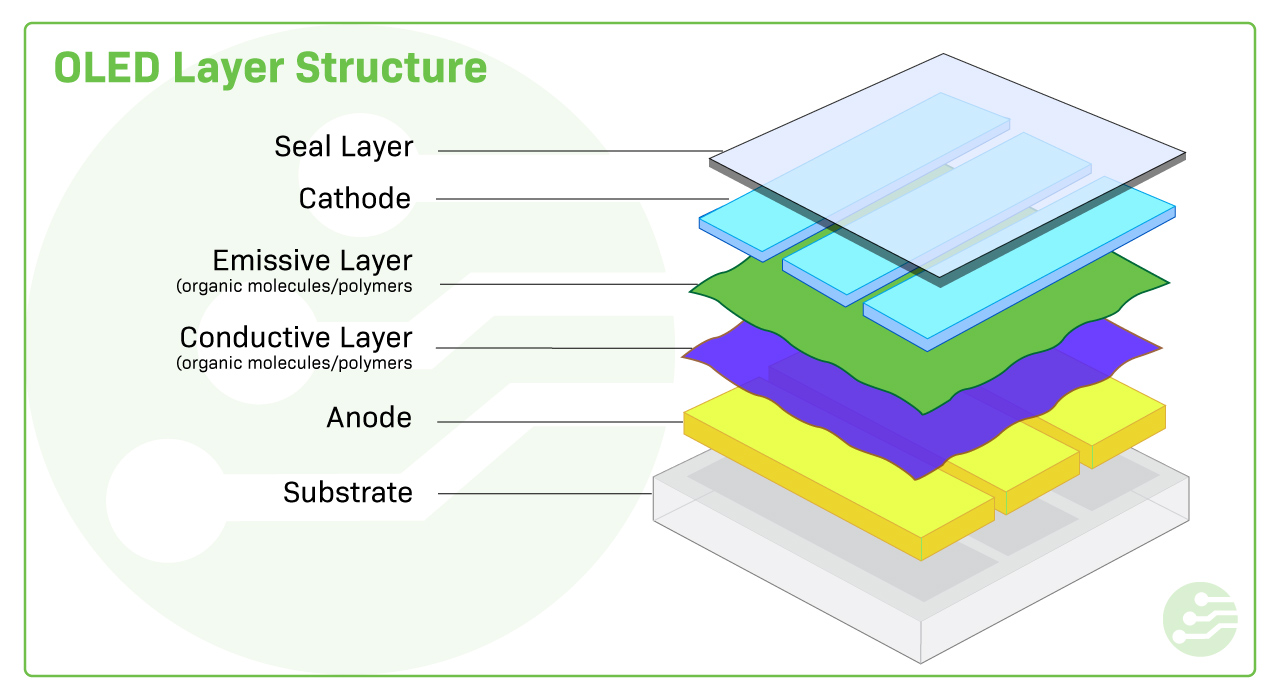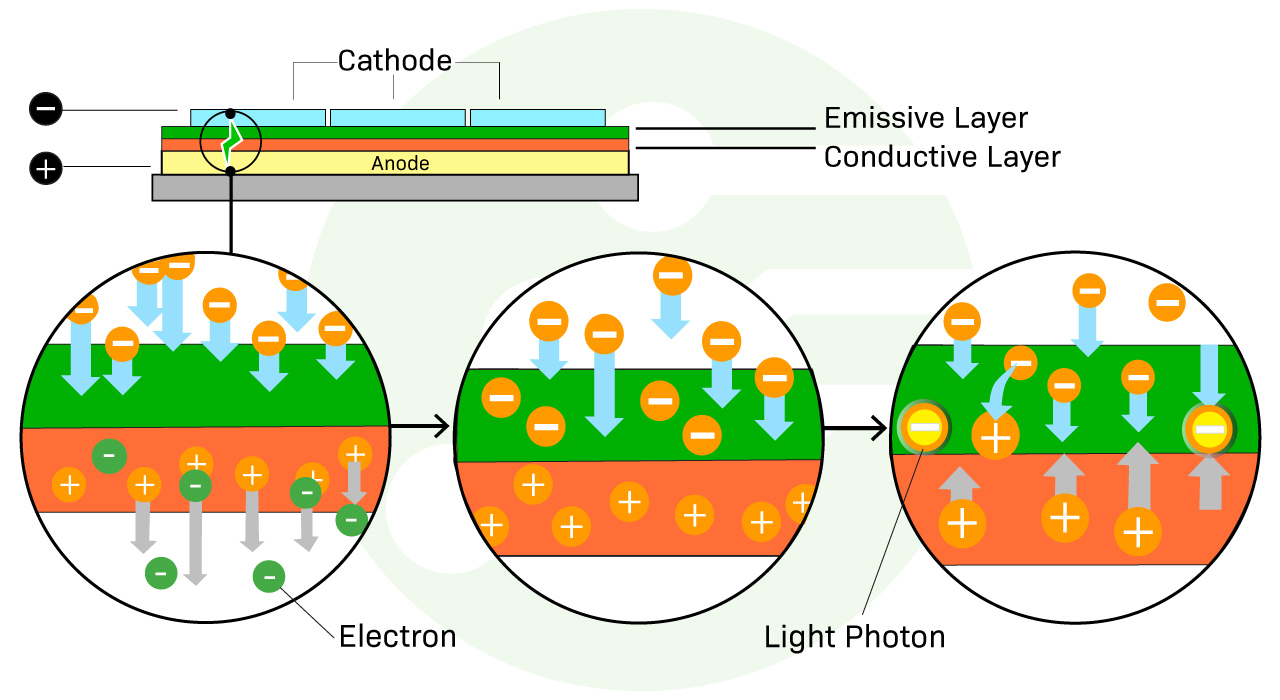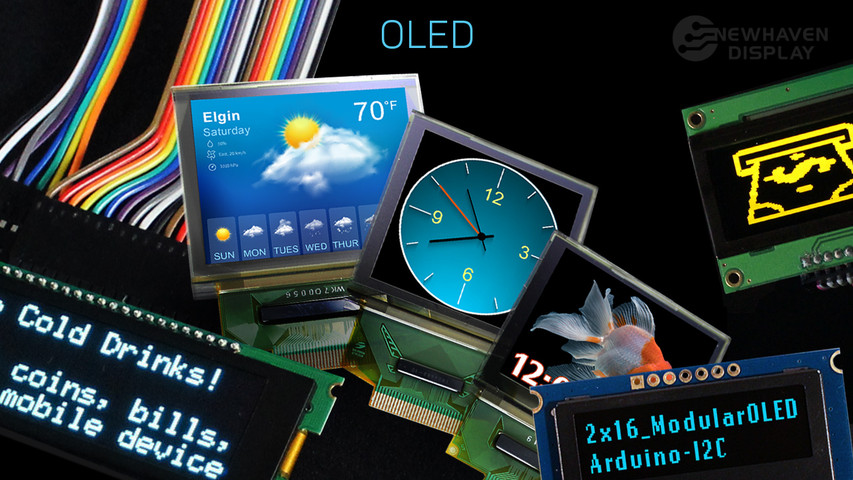OLED - Organic Light Emitting Diode
OLED displays take a unique approach to display technology that makes them slimmer and lighter than their LCD counterparts. OLED technology has become more common in recent years and is now a widely available display option for many applications – so why should you use it?
In this post, we’ll break down how OLED technology works, how it can improve your next project, and how it’s already changing the face of display technology.
In this article:
What is an OLED?
OLED (organic light-emitting diode), also known as organic LED is a light-emitting diode that emits light when an electric current is passed through its emissive layer. OLEDs use organic materials to emit light, rather than traditional backlighting used in LCD displays. This allows for less power consumption, better contrast, deeper blacks, and more vibrant colors.
OLEDs are used to create flat-panel displays in a wide variety of industries and applications. Because they are thin, energy efficient, and have fast response time and wide viewing angles, OLED displays are used in devices such as smartphones, smartwatches, industrial controls, lab equipment, and automotive indicators.
Related: OLEDs in Wearable Devices

The main components of an OLED display are the cathode, anode, emissive layer (light-emitting organic layer), and the conductive layer.
Organic materials used in OLEDs
The cathode is a layer of metal or other conductive material that serves as the source of electrons. The anode, which allows electricity to flow through the device, is typically made of a transparent conductor, such as indium tin oxide (ITO), which has high electrical conductivity and high optical transparency.
The organic layers are sandwiched between the anode and cathode and are responsible for emitting light when an electric current is applied. The conductive layer is commonly made of Polymers such as Polyaniline. Depending on the OLED use and design, the emissive layer is often made of organic compounds such as Tris (8-hydroxyquinoline) aluminum, Polyfluorene, or Triphenylamine.
How do OLEDs work?
An OLED is a type of LED in which the emitting layer is made of organic compounds that produce light when an electric current is applied. The layer typically consists of a polymer substance sandwiched between two electrodes, a cathode, and an anode. When a current is applied, it causes the organic molecules to emit light.
OLEDs work similarly to LEDs, but instead of using n-type and p-type semiconductor layers, they use organic compound layers to produce light.
How OLEDs produce light
OLEDs use a technique known as electroluminescence, in which a material emits light in response to the flow of an electric current. An OLED layer of organic materials is sandwiched between a cathode and an anode. When a current is applied to the OLED, negatively charged electrons flow from the cathode to the anode, while positively charged holes flow in the opposite direction. These electrons and holes recombine in the organic layer, releasing energy in the form of light.

- Current is applied between the cathode and anode.
- As electricity starts to flow from the cathode to the anode, the cathode gains electrons while the anode loses electrons, causing electron removal (electron holes) from the conductive layer.
- Electrons encounter electron holes at the edges between the emissive and conductive layers causing electrons to recombine and release their extra energy in the form of a photon of light.
Related: Nits vs Lumens vs Luminance
The color of the light emitted by an OLED depends on the specific organic materials used in the device.
Video demo of our 4x20 slim OLED display
OLED Advantages
OLED displays are superior to LCDs in several ways. They are slimmer and lighter, making them perfect for portable devices such as smartphones, laptops, fitness trackers, AR/VR headsets, and other wearable devices. Additionally, OLEDs offer wider viewing angles, wider operating temperatures than standard TN LCDs, providing a more vivid and immersive viewing experience. The contrast is also better on OLEDs, resulting in deeper blacks and more defined images. Furthermore, OLEDs are more energy efficient than LCDs, making them a more environmentally friendly option. Overall, OLEDs offer a more vibrant and dynamic viewing experience, with better color reproduction, fast response times, and deeper blacks.
- Slim and light
- High contrast
- Wide operating temperatures
- Vibrant colors
- Wide viewing angles
- Deep black colors
- Fast response times
- Energy efficient
OLED Disadvantages
Because OLEDs don’t need a backlight to illuminate the screen, an OLED’s brightness cannot be increased as easily as an LCD. It is common for OLEDs to look very bright in a typical indoor application but might not be as visible in direct sunlight compared to an LCD. The brightness of an OLED is also directly related to the lifetime of the organic material. While it may become more economical in the future to manufacture OLEDs, the current manufacturing process of OLEDs is more costly than LCDs.
- Shorter lifespan compared to LCDs
- Power consumption increases with white background images
- Readability may be a problem in direct sunlight conditions.
- Higher cost than LCDs (currently)
Conclusion
OLED technology is changing the display landscape by offering adaptive, self-illuminating displays with a significantly thinner and lighter design. They’re commonly found today as digital displays in applications ranging from smartphones, televisions, video monitors, tablets, smartwatches, and fitness trackers to medical devices, automotive gauges, audio players, headsets, cameras and game consoles. Their unique organic materials allow them to be more flexible, leading to some of the most exciting and innovating designs in display technology.
Related: OLED vs LCD
Latest Blog Posts
-
Arduino vs Raspberry Pi vs BeagleBone: Key Features and Differences
If you're working on an electronics project—whether it's for a DIY automated device, a digital sign, …Dec 8th 2025 -
Passive Matrix vs Active Matrix - A Beginner's Guide
Have you ever wondered how display screens are able to produce sharp images and vibrant colors? The …Dec 5th 2025 -
Nits vs Lumens vs Luminance: Key Differences Explained
While looking at some of the many light-emitting devices, such as televisions, LCDs, or light bulbs, …Nov 21st 2025





